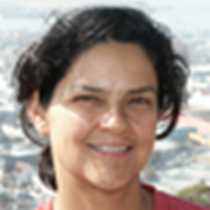Isla Monserrat & Isla Danzante
New Year’s morning greeted us with a spectacular colorful sunrise as the National Geographic Sea Lion navigated towards our morning destination: Monserrat Island. We landed on a rocky formation containing pieces of shells that tell the story of this volcanic island. It had been submerged before lifting by the geological processes that formed it, exposing the ancient sea floor. At this island we had the opportunity to hike into a lush environment through the dry arroyo. The recent rains had left green leaves everywhere and the scent of different herbs was in the air. Tronador vines covered larger perennials like tinsel on Christmas trees. The fragrance of pore leaf, or fisherman’s cilantro, filled the air. We also spent time observing insects and the island’s avian inhabitants, such as the Costa’s Hummingbird and the Northern Mockingbird.
We shared our island findings over a delicious lunch of pozole, while navigating towards Danzante Island. However, our route was interrupted when we caught sight of our first whales for 2009. Whatever we saw was huge, had a small dorsal fin and was blue. Yes, it was a blue whale! There was not one whale, but two blue whales! They were mother and calf. We were delighted to spend a whole hour with two representatives of the largest animals that have ever existed on Earth! The calf, probably only 28 feet long and weighing around 4 tons, was staying closer to the surface. Mom would go a little deeper but not for long and not too deep. The triangular flukes that are typically raised during a dive, time and again failed to make an appearance. The mother insisted on being close to her calf. She frequently returned to the surface to perhaps nurse the little whale. During approximately six months, baby blue whales travel with their moms, nursing and gaining 200 pounds a day. Watching a baby blue whale left us with the good feeling that there is hope for this endangered species of baleen whale.
Soon we continued on towards Danzante (“the dancer”) Island leaving the gentle giants behind.
Isla Danzante had a lush vegetation of cardones, agaves, salvias and desert bushes. However, instead of hiking we submerged ourselves in the refreshing waters of an enclosed bay. We witnessed a diversity of fish swimming among the rocks. Those of us who opted for a long paddle in kayaks encountered groups of mobula rays leaping out of the water.
After a brief stop at our vessel to get warmer clothes, we jumped back in the zodiacs and headed back to the beach. Here we were treated to a BBQ dinner and a bonfire where we enjoyed songs, stories, new friends and s’mores.
What a wonderful way to start a new year!
New Year’s morning greeted us with a spectacular colorful sunrise as the National Geographic Sea Lion navigated towards our morning destination: Monserrat Island. We landed on a rocky formation containing pieces of shells that tell the story of this volcanic island. It had been submerged before lifting by the geological processes that formed it, exposing the ancient sea floor. At this island we had the opportunity to hike into a lush environment through the dry arroyo. The recent rains had left green leaves everywhere and the scent of different herbs was in the air. Tronador vines covered larger perennials like tinsel on Christmas trees. The fragrance of pore leaf, or fisherman’s cilantro, filled the air. We also spent time observing insects and the island’s avian inhabitants, such as the Costa’s Hummingbird and the Northern Mockingbird.
We shared our island findings over a delicious lunch of pozole, while navigating towards Danzante Island. However, our route was interrupted when we caught sight of our first whales for 2009. Whatever we saw was huge, had a small dorsal fin and was blue. Yes, it was a blue whale! There was not one whale, but two blue whales! They were mother and calf. We were delighted to spend a whole hour with two representatives of the largest animals that have ever existed on Earth! The calf, probably only 28 feet long and weighing around 4 tons, was staying closer to the surface. Mom would go a little deeper but not for long and not too deep. The triangular flukes that are typically raised during a dive, time and again failed to make an appearance. The mother insisted on being close to her calf. She frequently returned to the surface to perhaps nurse the little whale. During approximately six months, baby blue whales travel with their moms, nursing and gaining 200 pounds a day. Watching a baby blue whale left us with the good feeling that there is hope for this endangered species of baleen whale.
Soon we continued on towards Danzante (“the dancer”) Island leaving the gentle giants behind.
Isla Danzante had a lush vegetation of cardones, agaves, salvias and desert bushes. However, instead of hiking we submerged ourselves in the refreshing waters of an enclosed bay. We witnessed a diversity of fish swimming among the rocks. Those of us who opted for a long paddle in kayaks encountered groups of mobula rays leaping out of the water.
After a brief stop at our vessel to get warmer clothes, we jumped back in the zodiacs and headed back to the beach. Here we were treated to a BBQ dinner and a bonfire where we enjoyed songs, stories, new friends and s’mores.
What a wonderful way to start a new year!




